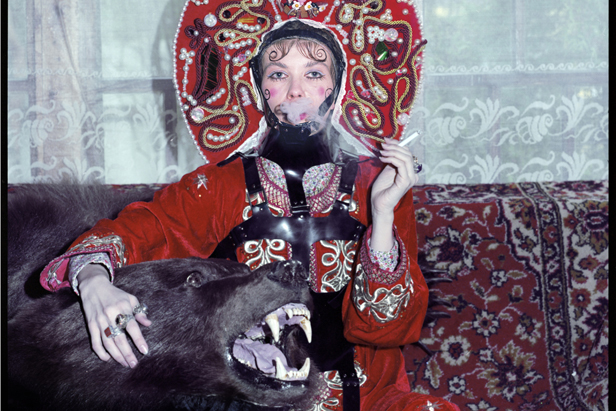Russian fairy-tales through the prism of post-modernism


140 years ago one of the greatest fairy tale authors, Hans Christian Andersen, the father of The Little Mermaid and Thumbelina and many other wonderful characters, passed away. He, along with the Grimm brothers, Charles Perrault, Astrid Lindren and Alexander Pushkin, invented stories for children, most of which were based on folk tales. That is why fairy tales in every culture seem similar. It’s hard to know what such authors borrowed from national legends and what they invented, but that doesn’t change anything.
Uldus Bakhtiozina
This photo project, called “Russ Land,” is made by renowned photographer Uldus Bakhtiozina from St. Petersburg. She revamps the image of some of Russia’s best loved fairy-tale characters. // Vasilisa Mikulishna comes from a folk legend about a wise and courageous woman who dresses up as a man to save her husband's life. Early Slavic feminism in a nutshell.
Uldus Bakhtiozina
The Firebird (Zhar-ptitsa) is a Russian version of the legend of the Phoenix. Usually the bird is a lure for brave young men who seek fame and fortune. The Firebird is a large bird of extraordinary beauty, enveloped in fire. Despite this magnificent appearance, it’s easy to capture the Firebird for illicitly eating the apples in the Tsar’s garden.
Uldus Bakhtiozina
Masha and the Bear is a fairy tale about a little girl who loses her way in the forest and stumbles across an izba (log house), home to a family of bears. Only her quick-wittedness saves her from death.
Uldus Bakhtiozina
Baba Yaga is one of the most frequently encountered characters in fairy tales. She’s most often found as the owner of a wooden hut on chicken legs, or as the guardian of the way into a wild wood. And she doesn’t let just anyone pass. Baba Yaga tests the hero’s nerve and courage. And if he proves worthy, she helps him along his way with his task, giving him talismans that will aid his work.
Uldus Bakhtiozina
Ivan the Fool doesn’t think before acting, and often does things randomly. Other people don’t take him seriously – at best they treat him like a fool, and at worst they push him around. Yet somehow he always blunders through thanks to some miraculous assistance, and ends up achieving feats that not even heroes can manage.
Uldus Bakhtiozina
Ryaba the Hen is the first fairy tale that Russian parents usually tell their toddlers. It's a tragic story about an old couple and their hen that lays a golden egg, which doesn’t bring them happiness.
Uldus Bakhtiozina
Tsarevna—the Eastern European version of Snow White/Sleeping Beauty—has left the home of the seven knights, or bogatyrs, and ventured forth into the dangerous world. But she still carries their images close to her as a protective talisman.
Uldus Bakhtiozina
Bogatyrs, a brotherhood of men living in the forest, have a huge power and they're often even immortal. The fairy tale about the dead princess and 7 bogatyrs is known to Russian children retold by Alexander Pushkin.
Uldus Bakhtiozina
The fairy tale about Frog Princess has the whole gamut of fantastic elements. Here you’ll find ritual, as the Crown Prince finds the frog with the aid of an arrow; there’s the breaking of rules – Ivan burns the frog’s skin, and loses his beloved; and in penalty for his transgression, he is assigned a trial which he must endure, in order to win his dear froggy back again.
Uldus Bakhtiozina
This pic is called Dragon Spirit, which is probably evoked by the 3-headed dragon Zmey Gorynich — the most dastardly of all Russian villains. Uldus Bakhtiozina decided not to make three scary dragon heads out of papier-mache — that would be too obvious. Here we see just hands with three cigarettes, a subtle hint.
Uldus Bakhtiozina
The Tale of the Fisherman and the Fish was also written by Pushkin and based on a folk legend. A simple fisherman catches a magic golden fish that can speak and grants three wishes in exchange for freedom.
Uldus Bakhtiozina
Uldus does not simply copy primitive ancient Russian dress and wear the obvious kokoshnik (headdress). She greatly refines these images, adds her own vision and value. She analyzes Russian fairy tales with a loving and, yes, slightly ironical eye. Imagine if Sofia Coppola were making film about Ancient Rus, inspired by Vasilisa the Wise instead of Marie Antoinette, she'd come up with something like this.
Uldus Bakhtiozina
The Scarlet Flower by Russian author Aksakov is based on a folk story that tells about a bewitched young man turned into a beast and a young maiden who removes the spell through her sincere love. Yes, it's a version of the famous Beauty and the Beast. // All costumes and details were made by the photographer, who was also the model for most of the photos. The series is still growing. There are still so many beautiful legends to tell, so many inspiring wisdoms to believe in.
Uldus BakhtiozinaAll rights reserved by Rossiyskaya Gazeta.
Subscribe
to our newsletter!
Get the week's best stories straight to your inbox